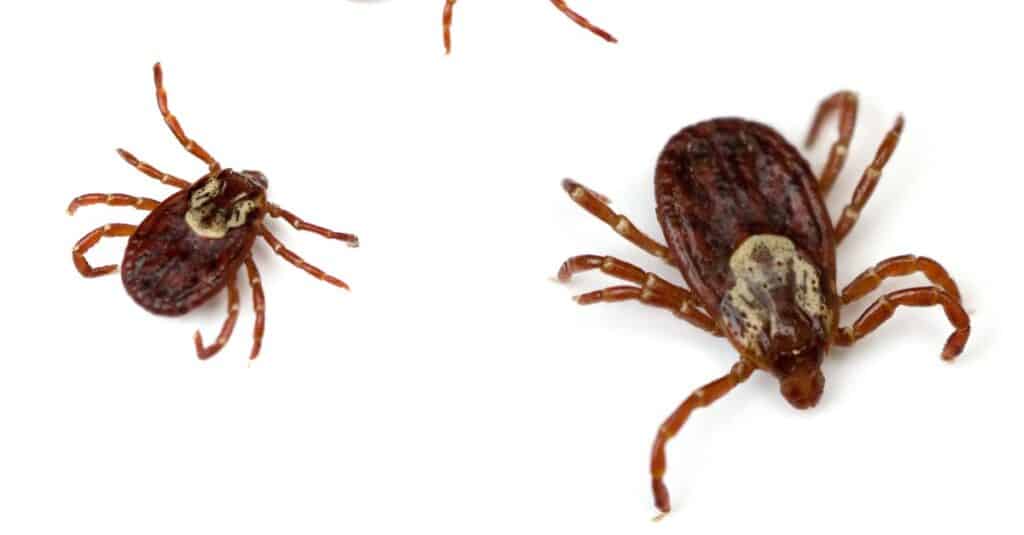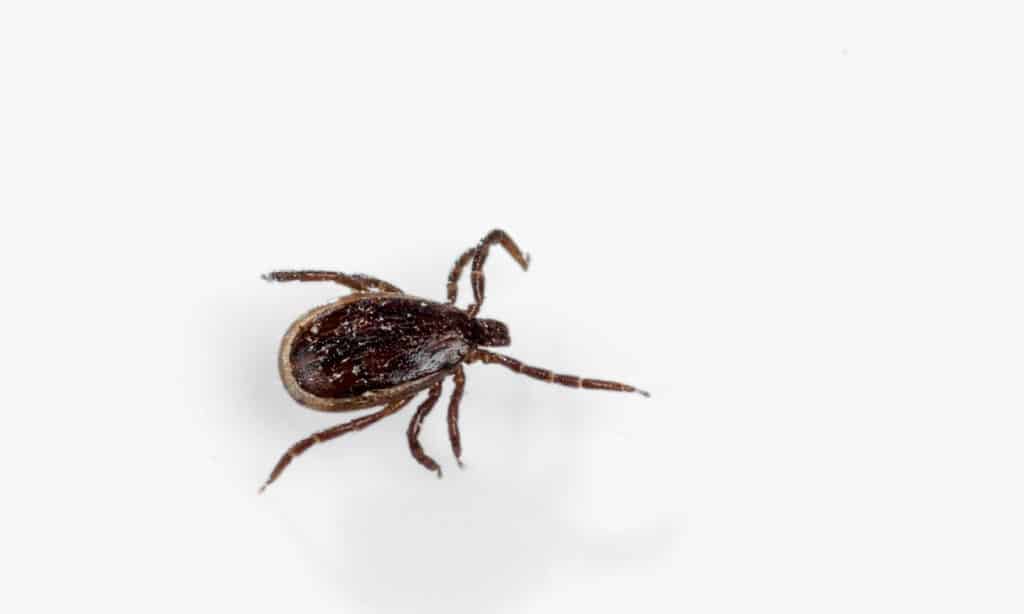All ticks in Texas start out life in eggs that look remarkably similar to tiny caviar. At birth, they’re known as larvae and have only six legs. After a single feeding, the ticks molt into nymphs and gain an extra set of legs. The nymphs feed once again and then molt into the most famous of all ticks—the adult tick. Most bites on humans come from adults, though larval and nymph-aged ticks are so small that most bites go unnoticed. Once the adults have drunk their fill of blood, they reproduce (with some species laying upwards of 10,000 eggs) and die.
Here, we’ll learn all about the most common species of ticks in Texas. Some of these ticks have worldwide distributions, while others are found primarily in the hot, humid parts of the world. We’ll learn how to identify each species and which ticks you should be worried about. Finally, we’ll go over what you should do if you find a tick embedded in your (or your companion’s) skin.
American Dog Tick

The American dog tick is one of the most common ticks in Texas.
©iStock.com/epantha
American dog ticks are among the most prevalent ticks in North America. They’re the primary vectors for Rocky Mountain spotted fever, though they don’t carry Lyme disease. These ticks are larger than other species. Females are readily identifiable by their brown bodies and tan scuta, while males have all-over tan and brown mottled bodies. American dog ticks are also known as wood ticks, though they prefer grasslands over wooded areas.
Winter Tick

As their name suggests, winter ticks stay active in the fall and winter months.
©iStock.com/VladK213
They may live just about everywhere, but you’re not too likely to see a winter tick unless you hunt big game. Winter ticks spend their entire lives on a single host. Their favorites are moose, elk, and deer, but they’ll also feed on bears, cattle, or other livestock if given the chance. Winter ticks don’t bite humans, and they’re generally only encountered by hunters in the fall and winter.
Lone Star Tick

Lone star ticks are among the most common ticks in Texas.
©iStock.com/epantha
Female lone star ticks are among the most recognizable ticks out there. They have a single tan dot in the center of their back, known as the lone star marking. Males lack this dot and instead have some tan mottling. Lone star ticks feed on coyotes, rabbits, deer, dogs, humans, and other animals. They don’t transmit Lyme disease, but they do carry human monocytic ehrlichiosis.
Deer Tick

Also known as black-legged ticks, deer ticks are the sole vectors for Lyme disease in the United States.
©KPixMining/Shutterstock.com
Deer ticks are found wherever there are white-tailed deer. Deer are, unsurprisingly, their favorite source of blood. These ticks transmit Lyme disease, which they get from feeding on mice during the larval stage. Deer ticks have large mouthparts and black legs. Females have orange bodies with black scuta, while males have dark brown bodies. Deer ticks are the only ticks in Texas with black legs, so they should be easily identifiable.
Brown Dog Tick

Brown dog ticks are so good at colonizing human habitations.
©iStock.com/Goldfinch4ever
You won’t find brown dog ticks in Texas outdoors. Instead, these ticks colonize our homes; wherever there are domestic dogs, there are probably brown dog ticks. These are the only species of tick in North America that live indoors. They’re typically found in dog beds, kennels, or buildings that dogs frequent. Brown dog ticks have narrow, brown bodies with small mouthparts. If you find a dog tick embedded in your dog, remove it as soon as possible and contact your vet.
Where are Ticks in Texas Found?
The best way to find a tick is to go out into the tall grass or thick undergrowth and walk around. Ticks can’t jump or fly. Instead, they rely on prey brushing up against the bushes or grass that they cling to. They’re also common in the dead leaves on the forest floor. Larval and nymph-aged ticks are particularly fond of plant detritus, so it’s best not to go digging around in the forest.
Do Ticks in Texas have Lyme Disease?

There are deer ticks in Texas, but there are very few cases of Lyme disease in the state.
©Kalcutta/Shutterstock.com
Yes, one tick in Texas carries Lyme disease, and that’s the deer tick. Luckily, Texas is home to few cases of Lyme disease. However, if you’re bitten by a deer tick, you should send the tick to a tick testing lab to have it tested for Lyme disease. You should also consult your primary care physician and self-monitor for any symptoms of Lyme disease.
How to Remove a Tick
One of the keys to reducing your risk of contracting a tick-borne illness is performing self-checks for ticks after all outdoor activities. So, let’s say you find a tick embedded in your skin, happily sucking away at your blood; what do you do? The most important thing to remember is that the quicker you get it out, the better.
To remove a tick, firmly grasp it as close to the skin as you can. Then, pull slowly but firmly, being careful not to squish the tick, straight back from the mouth. The tick should come out as one piece; it may take a little skin with it. Once removed, cleanse the bite with rubbing alcohol or soap and water. If you’re worried, kill the tick with rubbing alcohol, then mail it to a tick testing lab to see if it carried any diseases that it might have transmitted to you.
The photo featured at the top of this post is © Maria T Hoffman/Shutterstock.com
Thank you for reading! Have some feedback for us? Contact the AZ Animals editorial team.






